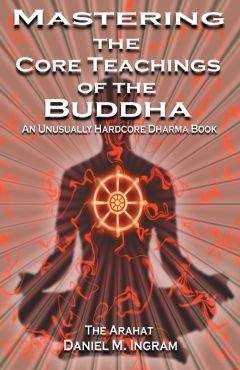Daniel Ingram - Mastering the Core Teachings of Buddha - An Unusually Hardcore Dharma Book
На сайте mybooks.club вы можете бесплатно читать книги онлайн без регистрации, включая Daniel Ingram - Mastering the Core Teachings of Buddha - An Unusually Hardcore Dharma Book. Жанр: Прочее издательство -,. Доступна полная версия книги с кратким содержанием для предварительного ознакомления, аннотацией (предисловием), рецензиями от других читателей и их экспертным мнением.
Кроме того, на сайте mybooks.club вы найдете множество новинок, которые стоит прочитать.

Daniel Ingram - Mastering the Core Teachings of Buddha - An Unusually Hardcore Dharma Book краткое содержание
Mastering the Core Teachings of Buddha - An Unusually Hardcore Dharma Book читать онлайн бесплатно
Buddhism vs. The Buddha
America, a whole new layer of cultural dust is being added to it, most of which is related to the shadow sides of Western psychology and those of the New Age movement. However, there are also signs that fresh new life and health is being breathed into aspects of Buddhism that had become somewhat moldy and calcified in their countries of origin.
The extra trappings are not necessarily all harmful in and of themselves, but they may dilute the amount of practical information about how to awaken with all sorts of other information that may have little to do with awakening and may even be an impediment to it. This may then lead to less than complete emphasis on the three fundamental trainings in morality, concentration and wisdom, which are quite a handful and a great undertaking even in their most simple forms. I was extremely lucky, in that I learned some great Buddhist meditation technology long before I really got to know the culture of mainstream Western Buddhism. I have much use for the former, and as for the latter, well, read on.
It is true that Buddhist training can take on many valid forms, and this is a fine and beautiful thing, as different training methods may be appropriate for different meditators at different times. The added
“padding” of tradition and religion can be a comfort and a support, as most people seem to really like having some kind of dogmatic, mythical or cultural foundation from which to work.
Traditions and standardized conceptual frameworks can also
provide the means by which people can talk to each other about experiences and techniques that might otherwise be very hard to explain clearly. I have a friend from another mystical tradition who knows much that I find useful and interesting, but it took us months to even begin to line up our terminology so that we could benefit from each other’s understanding.
However, these conceptual frameworks and trappings may also
produce the huge amount of useless, harmful and divisive sectarianism that exists within Buddhism and between the various meditative or mystical traditions, as well as all sorts of effort going into things that produce no freedom and may cause other forms of suffering.
Every time I leave my sheltered little academic life and enter the rough and tumble world of endlessly petty, sectarian dharma scenes, I 93
Buddhism vs. The Buddha
am again astounded at how fixated people can be on the minute differences between their tradition and traditions that are so similar to theirs they can only be differentiated by the clothes people wear and the names they call things. I can’t tell you how tiring it is. Sometimes I wonder how these otherwise kind and reasonable people can stand themselves or each other when they are like that. We all want to be special, but I beg you, find a way to be special that allows others to be special also. It is what is common to the great mystical paths that makes them special. The differences are 100% guaranteed to be fundamentally irrelevant. Now, that said, I am going to turn around and bust on cultural aspects of traditions that are not into awakening and mastering what the Buddha was talking about. This is Buddhism, after all, and so it seems only natural that I should be into what the old boy was into.
I have heard way too many conversations between members of
differing mystical traditions that could be summarized, “My dogma and ideals are better than your dogma and ideals.” Even worse are the rare and astonishing conversations that might be summarized, “My dogma and ideals are better than your actual realizations and profound insights.” Frightening.
There is a movement in the West, reminiscent of the original objectives of the Buddha in the early days of his teaching, to divorce Buddhism’s core meditation technology and basic trainings from religion and ritual entirely. I am a great fan of this movement, so long it does not cause people to throw out too many of the original Buddhist conceptual frameworks that are helpful as tools for mastering these practices. There is also a movement in the West to take the meditative technology of Buddhism and integrate it into everything from Catholicism to psychiatry to the freakish fringe of the New Age. I don’t have a problem with this trend particularly, just as long as people realize that you could just as easily divorce these technologies from those traditions and have something that is still very useful and powerful.
There is another related movement in the West, and that is to make Buddhism into something for everyone. Unfortunately, what is happening is that Buddhism is becoming watered down in order to make it have broad appeal. The result is something very similar to what happens in places like Thailand, where most people “practice 94
Buddhism vs. The Buddha
Buddhism” in a way that is largely devotional and dogmatic. In the West, this translates to people “practicing Buddhism” by becoming neurotic about being Buddhist, accumulating lots of pretty books and expensive props, learning just enough of some new language to be pretentious, and by sitting on a cushion engaged in free-form psychological whatnot while doing nothing resembling meditative practices. They may aspire to no level of mastery of anything and may never even have been told what these practices were actually designed to achieve.
Thus, their meditation is largely a devotional meditation, something that externally looks like meditation but achieves little. In short, it is just one more spiritual trapping, though one that may have some social benefits. Many seem to have substituted the pain of the pew for the pain of the zafu with the results and motivations being largely the same. It is an imitation of meditation done because meditation seems like a good and noble thing to do. However, it is a meditation that has been designed by those “teachers” who want everyone to be able to feel good that they are doing something “spiritual”. While it is good for a person to slow down to take time out for silence, I will claim that beyond these and a few cardiovascular benefits there is often not a whole lot of any great worth that comes from this sort of practice. True, they are not out smoking crack, but why get so close to the real thing and then not do those practices that make a real difference?
Many will consider my devaluation of low-grade sitting practice radical and counterproductive. Perhaps it is, but I claim that many who would have aspired to much more are being short-changed by not being invited to really step up to the plate and play ball, to discover the profound capabilities hidden within their own minds. This book is designed to be just such an invitation, an invitation to step far beyond the increasingly ritualized, bastardized, and gutless mock-up of Buddhism that is rearing its fluffy head in the modern West and has a strangle hold on many a practice group and even some of the big meditation centers.
To be fair, it is true that spiritual trappings and cultural add-ons may, at their best, be “skillful means,” ways of making difficult teachings more accessible and ways of getting more people to practice correctly 95
Buddhism vs. The Buddha
and in a way that will finally bring realization. A fancy hat or a good ritual can really inspire some people. That said, it is lucky that one of the fundamental “defilements” that drops away at first awakening is attachment to rites and rituals, i.e. Buddhism, ceremony, specific techniques, and religious and cultural trappings in general.
Unfortunately, the cultural inertia of the religions of Buddhism is hard to entirely circumvent.
It need not be, if the trappings can serve as “skillful means,” but I assert that many more people could be much more careful about what are fundamentally helpful teachings and what causes division, confusion, and sectarian arrogance. Those who aren’t careful about this are at least demonstrating in a roundabout way that they don’t know what the fundamental teachings are for themselves and have attained little wisdom.
96
14.CONTENT AND ULTIMATE REALITY *
There is too much content-centered Buddhism and content-
centered spirituality in general. It is not that content isn’t important, but it is only half of the picture, and the half we are already quite familiar with and typically stuck in. By content, I mean everything except determined effort to realize the full truth of the Three Characteristics of impermanence, suffering, and no-self, i.e. to realize ultimate reality.
Perhaps two illustrations will help.
The first odd phenomenon I have noticed is that when students of meditation gather together to discuss Buddhism, they almost never talk about actual meditation practices in depth and detail. They almost never talk about their diligent attempts to really understand these teachings in each moment. It is almost an unacknowledged taboo that nearly any politically correct topic under the Sun is acceptable as long as it doesn’t have to do with trying to master meditation techniques. While there are sporadic moments of “dharma combat” or heated discussion for the purpose of learning and sharing the dharma, even these tend to be mostly on the philosophy of all of this.
The second odd phenomenon I have noticed has occurred in
situations when one might suspect that there would not be this problem.
I have been to a fair number of retreats in the West, and these tend to have small group meetings. The dharma teachers have invariably been giving instructions that emphasize following the motion of the breath or the sensations of the feet, developing concentration on these objects, not being lost in thought, and giving precise attention to bare reality just as it is. They tend to use the phrase “moment to moment” often, which in my book means, “Fast!” This is all as it should be.
They tend to mention things like impermanence, suffering, and no-self, and tend to advocate trying to understand these qualities of all experience directly without the elaboration of thought. They mention time and time again that one should not be lost in the stories and tape loops of the mind. They may have traveled thousands of miles at great expense to help people understand these teachings that they themselves may have spent many years learning. For the hundreds of dollars in retreat fees, donations, and spent vacation time, the students will perhaps get three meetings with the teacher during a 10-day retreat and Content and Ultimate Reality
perhaps get fifteen to twenty precious minutes of time to talk to a real meditation master, assuming they are lucky enough to actually be sitting with one.
However, when some eight to ten students finally get a chance to meet with the teacher in a small group meeting, a brief chance to really learn what this teacher has to teach, what happens? Do they talk about their whole-hearted attempts at following the careful and skillful instructions of the teacher? Strangely, this only seems to happen on rare occasions.
I was at one of these small group meetings where everyone was talking about their neurotic stuff. In a moment of feeling like I might be able to actually add something useful, I said in a loud and exasperated voice, “The breath! Is anyone trying to notice the breath?” They just looked at me like I was out of my mind and went back to whining about their psychological crap. Here was a roomful of otherwise accomplished adults who somehow had been transformed into needy and pathetic children without any obvious ability to deal with their lives or follow very basic instructions. Beware of meditation cultures that consistently encourage this in people. It is a mark of something gone horribly wrong.
Stranger even than this, when students actually do talk about trying to follow the careful instructions of their meditation teachers, it can occasionally seem to be such a shock to teachers, such a violation of the unwritten taboos, and perhaps even such a threat to the hierarchy that they sometimes hardly seem to know how to handle it. In my more cynical moments, I have sometimes suspected that the quickest way to get worried looks from many modern Western meditation teachers is to talk about practice in a way that implies the attempt to actually master anything.
Most of the time students tend to whine about their relationships, their childhood, their neurotic thoughts, their screwed up lives, in short, content. I must say that I have great sympathy for these people. I really do. God knows we all have this sort of stuff to whine about; and, in the right context, whining about our stuff might be a very good idea. But two things are fairly clear: these people have spent too little time in therapy (or perhaps too much time in bad therapy), and somehow have not 98
Content and Ultimate Reality
heard one word of what the teacher has been talking about as regards insight practice.
Now, it is absolutely true that we all have our issues, pains, traumas, scars and quirks. We have to learn to deal with these somehow if we want to be happy and live the good life we all want to live. We have to find ways to deal with the content, to heal, to grow, to mature, and all of that, but we must also learn when to shift to seeing things on a completely different level. There is a time and a place for everything.
Imagine if you were an algebra teacher and you told your students to solve the homework in the back of chapter one. Instead, your students turn in long, rambling essays about the traumas of their childhood. How would you feel? Unfortunately, you would feel like many meditation teachers. Now, it is true that many dharma teachers have a great time helping people deal with their stuff, and some of these are even quite good at it. There are others that put up with having to play this role, but they would prefer to be teaching insight practices. Some teachers just can’t stand it when they spend lots of time giving careful instructions only to have very few people follow them, particularly when they know what an amazing opportunity for even deeper healing, increased wellbeing and clarity is being squandered by their students when they fail to really practice.
Sometimes people have actually heard just a bit of the teachings on impermanence, suffering and emptiness, but then proceed to talk about this in highly content-centered terms. They may say things like, “Oh, yes, I am impermanent and will die one day. This is awful and this thought causes me suffering. Truly, I feel empty inside.”
This is macroscopic, about grand yet crude concepts and ideas, and so is still squarely in the territory of philosophy and existentialism. This meditator not only needs to learn what insight practice actually is, but might also benefit from a bit more sunshine and exercise or perhaps even some of those new anti-depressants. A very small amount of such reflection can be of some limited benefit if the energy of the frustration is directed into practice. There are other types of reflection that might be much more skillful, but those are largely a topic for another day (see Jack Kornfield’s A Path with Heart or Christopher Titmuss’ Light on Enlightenment).
99
Content and Ultimate Reality
If meditators would actually just go microscopic and try to see the Three Characteristics of each and every individual little sensation that makes up their experience, then they might begin to actually understand reality at the level that makes the difference. Effectively encouraging students to shift their attention from fixation on content and the macroscopic to also including the microscopic and universal is probably the hardest job of the meditation teacher. I sometimes wonder how many of them have largely given up trying to do this.
Похожие книги на "Mastering the Core Teachings of Buddha - An Unusually Hardcore Dharma Book", Daniel Ingram
Daniel Ingram читать все книги автора по порядку
Daniel Ingram - все книги автора в одном месте читать по порядку полные версии на сайте онлайн библиотеки mybooks.club.




